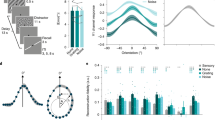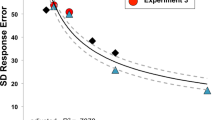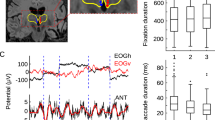Abstract
During the maintenance of visuospatial information, neural activity in the frontal eye field (FEF) persists and is thought to be an important neural mechanism for visual working memory. We used functional magnetic resonance imaging to examine whether human FEF activity persists when maintaining auditory space and whether it is selective for retinal versus extra-retinal space. Subjects performed an audiospatial working-memory task using sounds recorded from microphones placed in each subject's ear canals, which preserved the interaural time and level differences that are critical for sound localization. Putative FEF activity persisted when maintaining auditory-cued space, even for locations behind the head to which it is impossible to make saccades. Therefore, human FEF activity represents both retinal and extra-retinal space.
This is a preview of subscription content, access via your institution
Access options
Subscribe to this journal
Receive 12 print issues and online access
$209.00 per year
only $17.42 per issue
Buy this article
- Purchase on Springer Link
- Instant access to full article PDF
Prices may be subject to local taxes which are calculated during checkout








Similar content being viewed by others
References
Funahashi, S., Bruce, C.J. & Goldman-Rakic, P.S. Dorsolateral prefrontal lesions and oculomotor delayed-response performance: evidence for mnemonic 'scotomas'. J. Neurosci. 13, 1479–1497 (1993).
Curtis, C.E. & D'Esposito, M. The effects of prefrontal lesions on working memory performance and theory. Cogn. Affect. Behav. Neurosci. 4, 528–539 (2004).
Rivaud, S., Müri, R.M., Gaymard, B., Vermersch, A.I. & Pierrot-Deseilligny, C. Eye movement disorders after frontal eye field lesions in humans. Exp. Brain Res. 102, 110–120 (1994).
Dias, E.C. & Segraves, M.A. Muscimol-induced inactivation of monkey frontal eye field: effects on visually and memory-guided saccades. J. Neurophysiol. 81, 2191–2214 (1999).
Ploner, C.J., Rivaud-Pechoux, S., Gaymard, B.M., Agid, Y. & Pierrot-Deseilligny, C. Errors of memory-guided saccades in humans with lesions of the frontal eye field and the dorsolateral prefrontal cortex. J. Neurophysiol. 82, 1086–1090 (1999).
Bruce, C.J. & Goldberg, M.E. Primate frontal eye fields. I. Single neurons discharging before saccades. J. Neurophysiol. 53, 603–635 (1985).
Funahashi, S., Bruce, C.J. & Goldman-Rakic, P.S. Mnemonic coding of visual space in the monkey's dorsolateral prefrontal cortex. J. Neurophysiol. 61, 331–349 (1989).
Chafee, M.V. & Goldman-Rakic, P.S. Matching patterns of activity in primate prefrontal area 8a and parietal area 7ip neurons during a spatial working memory task. J. Neurophysiol. 79, 2919–2940 (1998).
Sommer, M.A. & Wurtz, R.H. Frontal eye field sends delay activity related to movement, memory and vision to the superior colliculus. J. Neurophysiol. 85, 1673–1685 (2001).
Umeno, M.M. & Goldberg, M.E. Spatial processing in the monkey frontal eye field. II. Memory responses. J. Neurophysiol. 86, 2344–2352 (2001).
Curtis, C.E. & D'Esposito, M. Persistent activity in the prefrontal cortex during working memory. Trends Cogn. Sci. 7, 415–423 (2003).
Treutwein, B. Adaptive psychophysical procedures. Vision Res. 35, 2503–2522 (1995).
Srimal, R. & Curtis, C.E. Persistent neural activity during the maintenance of spatial position in working memory. Neuroimage 39, 455–468 (2008).
Curtis, C.E. & D'Esposito, M. Selection and maintenance of saccade goals in the human frontal eye fields. J. Neurophysiol. 95, 3923–3927 (2006).
Curtis, C.E., Rao, V.Y. & D'Esposito, M. Maintenance of spatial and motor codes during oculomotor delayed response tasks. J. Neurosci 24, 3944–3952 (2004).
Brown, M.R.G. et al. Comparison of memory- and visually guided saccades using event-related fMRI. J. Neurophysiol. 91, 873–889 (2004).
Russo, G.S. & Bruce, C.J. Frontal eye field activity preceding aurally guided saccades. J. Neurophysiol. 71, 1250–1253 (1994).
Kikuchi-Yorioka, Y. & Sawaguchi, T. Parallel visuospatial and audiospatial working memory processes in the monkey dorsolateral prefrontal cortex. Nat. Neurosci. 3, 1075–1076 (2000).
Artchakov, D. et al. Processing of auditory and visual location information in the monkey prefrontal cortex. Exp. Brain Res. 180, 469–479 (2007).
Goldberg, M.E. & Bruce, C.J. Primate frontal eye fields. III. Maintenance of a spatially accurate saccade signal. J. Neurophysiol. 64, 489–508 (1990).
Russo, G.S. & Bruce, C.J. Effect of eye position within the orbit on electrically elicited saccadic eye movements: a comparison of the macaque monkey's frontal and supplementary eye fields. J. Neurophysiol. 69, 800–818 (1993).
Schall, J.D., Morel, A., King, D.J. & Bullier, J. Topography of visual cortex connections with frontal eye field in macaque: convergence and segregation of processing streams. J. Neurosci. 15, 4464–4487 (1995).
Tehovnik, E.J., Sommer, M.A., Chou, I.H., Slocum, W.M. & Schiller, P.H. Eye fields in the frontal lobes of primates. Brain Res. Brain Res. Rev. 32, 413–448 (2000).
Chen, L.L. Head movements evoked by electrical stimulation in the frontal eye field of the monkey: evidence for Independent eye and head control. J. Neurophysiol. 95, 3528–3542 (2006).
Elsley, J.K., Nagy, B., Cushing, S.L. & Corneil, B.D. Widespread presaccadic recruitment of neck muscles by stimulation of the primate frontal eye fields. J. Neurophysiol. 98, 1333–1354 (2007).
Knight, T.A. & Fuchs, A.F. Contribution of the frontal eye field to gaze shifts in the head-unrestrained monkey: effects of microstimulation. J. Neurophysiol. 97, 618–634 (2007).
Garg, A., Schwartz, D. & Stevens, A.A. Orienting auditory spatial attention engages frontal eye fields and medial occipital cortex in congenitally blind humans. Neuropsychologia 45, 2307–2321 (2007).
Mullette-Gillman, O.A., Cohen, Y.E. & Groh, J.M. Eye-centered, head-centered and complex coding of visual and auditory targets in the intraparietal sulcus. J. Neurophysiol. 94, 2331–2352 (2005).
Mullette-Gillman, O.A., Cohen, Y.E. & Groh, J.M. Motor-related signals in the intraparietal cortex encode locations in a hybrid, rather than eye-centered, reference frame. Cereb. Cortex 19, 1761–1775 (2009).
Soechting, J.F. & Flanders, M. Moving in three-dimensional space: frames of reference, vectors and coordinate systems. Annu. Rev. Neurosci. 15, 167–191 (1992).
Schlack, A., Sterbing-D'Angelo, S.J., Hartung, K., Hoffmann, K.-P. & Bremmer, F. Multisensory space representations in the macaque ventral intraparietal area. J. Neurosci. 25, 4616–4625 (2005).
Andersen, R.A. & Zipser, D. The role of the posterior parietal cortex in coordinate transformations for visual-motor integration. Can. J. Physiol. Pharmacol. 66, 488–501 (1988).
Mazzoni, P., Bracewell, R.M., Barash, S. & Andersen, R.A. Spatially tuned auditory responses in area LIP of macaques performing delayed memory saccades to acoustic targets. J. Neurophysiol. 75, 1233–1241 (1996).
Stricanne, B., Andersen, R.A. & Mazzoni, P. Eye-centered, head-centered and intermediate coding of remembered sound locations in area LIP. J. Neurophysiol. 76, 2071–2076 (1996).
Xing, J. & Andersen, R.A. Models of the posterior parietal cortex which perform multimodal integration and represent space in several coordinate frames. J. Cogn. Neurosci. 12, 601–614 (2000).
Paus, T. Location and function of the human frontal eye-field: a selective review. Neuropsychologia 34, 475–483 (1996).
Ikkai, A. & Curtis, C.E. Cortical activity time locked to the shift and maintenance of spatial attention. Cereb. Cortex 18, 1384–1394 (2008).
Curtis, C.E. & Connolly, J.D. Saccade preparation signals in the human frontal and parietal cortices. J. Neurophysiol. 99, 133–145 (2008).
Biswal, B.B. & Hyde, J.S. Contour-based registration technique to differentiate between task-activated and head motion-induced signal variations in fMRI. Magn. Reson. Med. 38, 470–476 (1997).
Zarahn, E., Aguirre, G. & D'Esposito, M. A trial-based experimental design for fMRI. Neuroimage 6, 122–138 (1997).
Worsley, K.J. & Friston, K.J. Analysis of fMRI time-series revisited—again. Neuroimage 2, 173–181 (1995).
Van Essen, D.C. Population-average, landmark- and surface-based (PALS) atlas of human cerebral cortex. Neuroimage 28, 635–662 (2005).
Holmes, A.P., Blair, R.C., Watson, J.D. & Ford, I. Nonparametric analysis of statistic images from functional mapping experiments. J. Cereb. Blood Flow Metab. 16, 7–22 (1996).
Nichols, T.E. & Holmes, A.P. Nonparametric permutation tests for functional neuroimaging: a primer with examples. Hum. Brain Mapp. 15, 1–25 (2002).
Curtis, C.E., Rao, V.Y. & D'Esposito, M. Maintenance of spatial and motor codes during oculomotor delayed response tasks. J. Neurosci. 24, 3944–3952 (2004).
Acknowledgements
We thank R. Srimal, L. Deouell, S. Inati and K. Sanzenbach for technical support and anonymous reviewers for helpful suggestions. This work was funded by the US National Institutes of Health (R01 EY016407).
Author information
Authors and Affiliations
Contributions
K.J.T. and C.E.C. designed and conducted the experiment, analyzed the data and wrote the manuscript.
Corresponding author
Supplementary information
Supplementary Text and Figures
Supplementary Figures 1–6, Supplementary Tables 1 and 2, and Supplementary Results 1 and 2 (PDF 1359 kb)
Rights and permissions
About this article
Cite this article
Tark, KJ., Curtis, C. Persistent neural activity in the human frontal cortex when maintaining space that is off the map. Nat Neurosci 12, 1463–1468 (2009). https://doi.org/10.1038/nn.2406
Received:
Accepted:
Published:
Issue Date:
DOI: https://doi.org/10.1038/nn.2406
This article is cited by
-
Causal influences of salience/cerebellar networks on dorsal attention network subserved age-related cognitive slowing
GeroScience (2023)
-
Spatial representations of the viewer’s surroundings
Scientific Reports (2018)
-
Beta Oscillatory Dynamics in the Prefrontal and Superior Temporal Cortices Predict Spatial Working Memory Performance
Scientific Reports (2018)
-
Irrelevant tactile stimulation biases visual exploration in external coordinates
Scientific Reports (2015)
-
A review of cell assemblies
Biological Cybernetics (2013)



